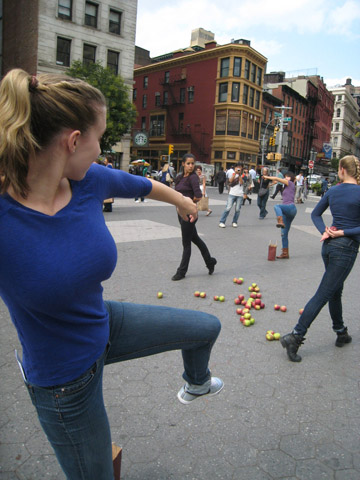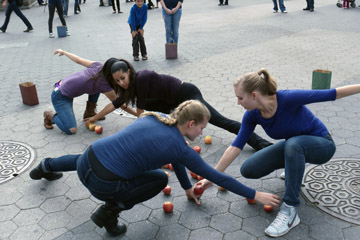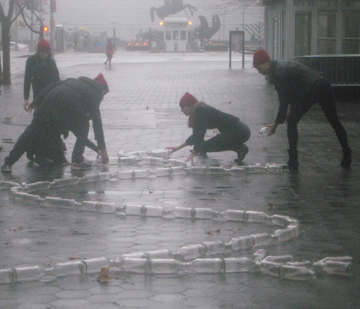Dance: The Equus Projects: OnSite NYC Without Horses
By Dawn Lille
ART TIMES Spring 2013
 OnSite NYC Event: Union Square, Migliorelli Farm Apples (Photographer, Alexandria Johnson) |
The Equus Projects is a modern dance company based in New York City. It aims to integrate the artistry of dance with that of horsemanship and was last written about in these pages in December, 2005. The news is that this season they began OnSite NYC, a 12-part series of site-specific works for urban landscapes with just humans and no horses.
Conceived 15 years ago by JoAnna Mendl Shaw, its director, the company has performed in the context of intensive residencies in, among other places, Montana, Washington, Virginia, Texas and Connecticut. The motivation behind this new endeavor is that the company, known for its large-scale performance pieces for dancers and horses, is almost never seen in New York City because the cost of bringing in and caring for the horses is prohibitive. Shaw’s desire to create visibility in a city where no one else is taking the same approach to creating dance, plus the fact that she is not interested in performance in a theater, led to her proposal for twelve different sites with a different work created for each.
The first, in September was Union Square, the second, in October was the Financial District. The November site, Tudor City Greens, had to be postponed due to Sandy. The fourth, on December 10 took place in Dag Hammarskjold Plaza and the fifth, in January, at the store Ligne Roset in Soho.
After many visits and an exploration of the site, a movement score, or rule structure, is prepared with the participation of the dancers. These scores, in all of which the dancers are engaged in real time on the spot decision making, are rigorous and exact. They call for a set of skills that are related to that particular site, with the place dictating the approach, e.g. its history, appearance, how pedestrians move through or around it.
Because there is also improvisation involved within this carefully orchestrated score, every performance (there is always more than one at each site) is different, with the unexpected regarded as magical and worked into the scene. It is important that there is no pretense in the dancers’ execution and that the reality of the situation is visible to the viewer.
 OnSite NYC Event: Union Square, Migliorelli Farm Apples (Photographer, Maegan Keller) |
The original plan for Union Square was to navigate the area on market days, but somehow they began to focus on objects and settled on apples from Migliorelli Farms. This resulted in a celebration of the harvest by 18 dancers (the company was augmented by students from the Alvin Ailey Dance School) and 300 apples. They built three separate apple mandalas in three performances.
The skills engaged were mirroring, eye/hand coordination and logging, or performing an exact duplication of what the leader is doing. There could also be a conscious decision to change. The rule for the mandalas themselves was that they had to be exactly bilateral.
During the first presentation Joseph, a young boy of about nine, stood staring for a few minutes and then walked into the midst of the dancers and started to mimic one. When he came back and looked at the huge pile of apples Shaw told him to find a space and build his own design, using as many as he wished. For the second performance the dancers told him to make a round mandala and for the third they build theirs around his. Joseph’s mother remained out of sight and allowed the whole process to unfold.
Company rehearsals are for the skills needed for a particular site, but all stress the importance of physical listening, which is akin to body awareness of another human being. For Union Square they experienced seeing a movement before mirroring it, the choices involved in making a mandala (they settled on exact placement of the apples), how to be a leader by indicating spatial intent to your partner and how to have a movement conversation. The emphasis in rehearsals is that of movement in three-dimensional space.
 OnSite NYC Event: Ligne Roset (Photographer, Nir Arieli) |
There is also what the group calls the Alpha Plan, in which one dancer functions as the alpha or leader, directing the others to partner or copy him/her without any verbal clues. This role can be reassigned at any given moment and is always up for negotiation.
The question of who is the leader and whom the follower is different with horses than with humans. The horse is not aware of the process in which it is involved and can break the line of communication in a second. Hence one of the skills the dancers learn in rehearsal is how to calmly and creatively react to a sudden change or interruption while still following the given script at that moment in time. The audience at each performance is handed a brief explanation of what is taking place and is often asked to try and identify the leader.
In the Financial District the four company members, Tal Adler, Carlye Eckert, Jessica Martin and Rebecca Morin, wore business attire and began by walking with the pedestrians and then going into their dance. Here they used a quartet partnering form in which one person is the leader who is asking to be lifted. They made use of unison and improvisation at the same time. The leader always changed and the result looked totally choreographed, but was not. The skills involved leadership, physical listening, different kinds of touching and a concentration on what they wanted the audience to do.
 OnSite NYC Event: Dag Hammarskjold Plaza Photographer, Maegan Keller |
On Dag Hammarskjold Plaza, under a warm, gray, misty drizzle, with the United Nations to the east, the company was augmented by many guest dancers. They used clear glass milk bottles to create a tree and its branches on the pavement of the long rectangular pedestrian plaza. With their heads covered in red woolen caps, they engaged in interludes of short duets, trios and solos, gradually building momentum and height with the inclusion of the park benches.
Tudor City Greens is on the south green of Tudor City and part of the early exploration was a lengthy conversation with the gardener. Often the dancers are asked to create a particular character for a piece. In this case each of the women will focus on one thing: Rebecca the pseudo Gothic arch; Jessica the different plants and Carlye the image of a secret garden. This event will be mostly dance and will take place May 10.
Shaw is interested in observing the reaction of the audience to what is presented as a process-taking place as they watch it, not a spectacle. She wants it to be an immersive experience in which they look, are curious and realize this is an event in real time. She enjoys seeing how an audience gradually develops, or, in the case of Wall Street, how the dancers failed to attract many pedestrians or tourists – either because they were accustomed to strange events or because they were baffled.
To work with horses one needs or learns concentrated looking and physical listening habits, patience and compassion. These skills are, or should be, components of everyday life and human interaction, of government and of international affairs. Maybe in working without their equine partners the dancers of the Equus Projects, through their concentration on and response to each other, can entice their audiences to stop for a moment and think about what is taking place. What better way for art to make a contribution? Checkout their website: www.dancingwithhorses.org.
dawnlille@aol.com
